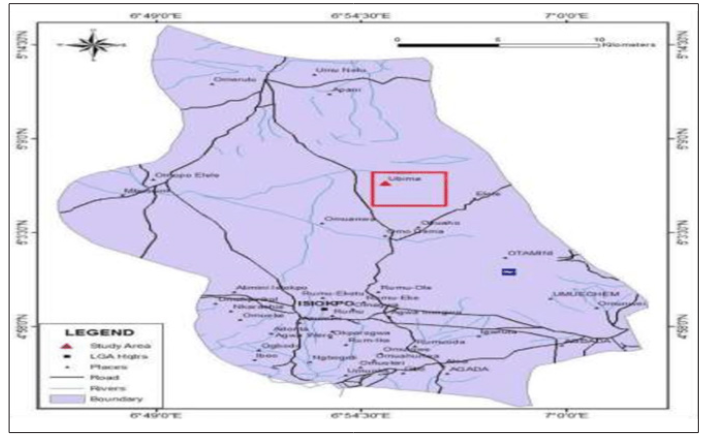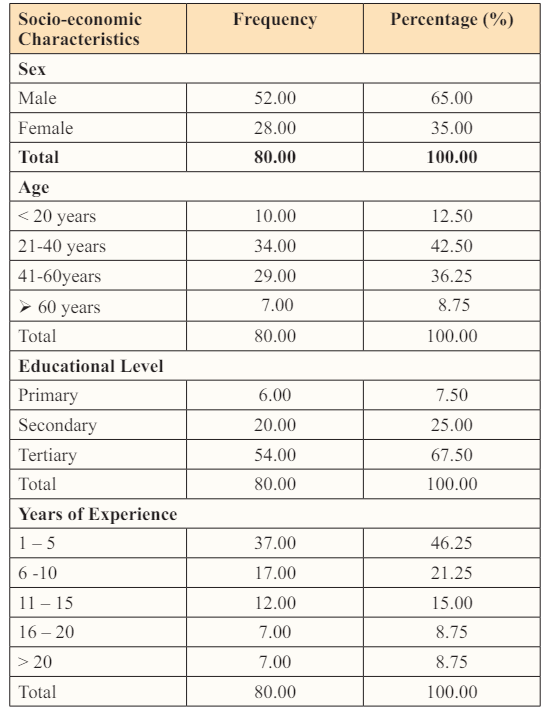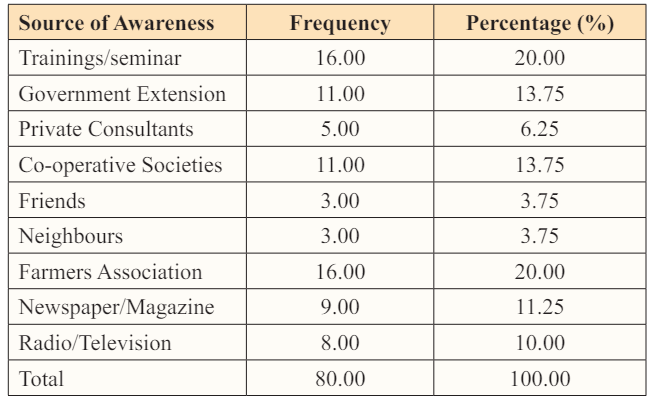Author(s): Abu OMG, Ayaobu-Cookey IK and Nwanyanwu UG
In Ikwerre Local Government Area of Rivers State, Nigeria, this study assessed farmers’ knowledge of and use of fish farming technology. In order to gather pertinent study data, a total of 120 structured questionnaires were given out; 80 of those were eventually retrieved. Using descriptive statistics, the study’s data were examined. The study’s findings showed that 95.0% of farmers were fully aware of some advancements in fish farming technology under consideration, 3.75 % were slightly knowledgeable, and 1.2 % were not. Through trainings and meetings with farmers associations, the majority of farmers became aware of this technical knowledge. The main barriers to the adoption of fish farming technology in these regions, on the other hand, were a lack of sufficient money, the high cost of fish feed, and weak extension linkages. It was suggested that government and non-governmental organizations establish intervention programs to guarantee that farmers adopt new technology through subsidies of aquaculture inputs, particularly feed.
In Nigeria, fish is one of the main sources of animal protein. Fish can be obtained in Nigeria either by catch fisheries, fish aquaculture, or importation of frozen fish [1]. In capture fisheries, wild fish are taken from naturally occurring stocks. Small-scale/ artisanal fishermen or business/industrial tourists can both accomplish this. Production in artisanal fisheries is accomplished by individuals or small groups using labor-intensive methods [2]. Fishers that practice artisanal fishing are known for using dugout, wooden boats that are frequently unmotorized. Fish production in Nigeria is now dominated by artisanal fisherman [3]. Additionally, according to FAO, protein intake in poor nations (like Nigeria) was lower than the recommended 75g per person per day [4]. Fish has long been recognized as a major source of dietary protein, according to Ajayi [5]. However, fish farming has the potential to create jobs for the nation’s teeming youth population, improve farmers’ socioeconomic standing, significantly boost Nigeria’s GDP, and employ over six million people directly and indirectly [6]. However, due to a lack of knowledge about the enhanced technology required to increase fish output in both urban and rural sections of the nation, aquaculture growth has been at a low ebb in several regions of the country for many years [7-9].
Research facilities and academic institutions have worked to create new technologies that would expand fish production in order to meet Nigeria’s growing demand for fish [10,11]. These technologies are new, enhanced theories, practices, inventions, and inputs that replace those that were previously in use. They offer a way to achieve a sustained rise in farm productivity, which in turn raises the standard of living for the populace [12]. But according to Barldam, relatively little of these technologies are being adopted by fish farmers [13]. This is brought on by a number of interrelated issues, including poor agricultural policies, an unfavorable institutional environment, and a bad socioeconomic climate. For agricultural progress, fish producers’ acceptance of new technologies is crucial. Numerous fishing technologies have been offered over a long period of time by research institutes, federal and state ministries of agriculture, and other associated agencies, but farmer response has been very poor and uninspiring [14,15]. People don’t simply adopt a technology because it is available to them, as has been highlighted. According to Berdgue and Eswbar’s argument,even when the technologies are suitable and readily accessible, some restrictions frequently have an impact on whether they choose to employ them or not [16].
Diverse training programs on the newest technologies in aquaculture have recently been held in Nigeria in order to achieve these goals, but less focus has been placed on determining how widely they have been adopted and the difficulties they have encountered along the production process [17]. To increase productivity, a number of fish farming technologies have been created and made available to farmers around the nation in recent decades. Techniques for fish farming have recently undergone some innovation. It is anticipated that the production of aquaculture in Nigeria will change as a result of effective dissemination of these technologies to farmers, their adoption, and their transmission [18,19]. The goals of new fish technology are to streamline processes and boost productivity. Therefore, it is important to look at how much technology has been transferred for fish farming [20, 21]. The use of these technologies by farmers is therefore something that has to be studied. As a result, this study assesses how well-known and widely used improved aquaculture technologies are in Ikwerre Local, Rivers State.
This study was carried out in Ikwerre Local Government Area of Rivers State of Nigeria. It is one of the 23 local government areas in the state. Its administrative seat is located in Isiokpo, it lies between latitude five (5°N’) North and mid-way between longitude five (5°S’) South of the Greenwich Meridian

Figure 1: Map of the Study Area
I. Improved techniques in pond construction and maintenance
II. Introduction of modern fish hatchery equipment
III. Introduction of improved fish seeds/species
IV. Aeration for transporting fingerlings to reduce stress and
mortality
V. Modern harvesting methods
VI. Improved water quality management
VII.Improved water quality management
VIII.Fortification of fish feed
IX. Prevention and control of fish diseases
X. Integrated fish farming and record keeping.
Random sampling techniques were employed in the selection of the samples. Data was collected by use of primary and secondary sources. Primary data was collected by use of interview schedule using questionnaires, while secondary sources were by use of textbook and Journal publication on Aquaculture and internet. Structured interview schedule was used to collect data from the fish farmers. 120 questionnaires were distributed only 80 were retrieved. Data from the study was analyzed by use of descriptive statistics
In this study some of the socio-economic characteristics of fish farmers were identified, studied and presented in Table 1. Male fish farmers significantly dominate the study area with a proportion of 65.0%. The economically active age groups consist of 21 - 40 years and 41 - 60 years which constitute 42.50 % and 36.25 % respectively of the respondents. Most of the respondents as shown in Table 1 were literate with primary, secondary or tertiary educational attainment. Majority of the respondents (46.25%) had 1-5 years farming experience.

The results of fish farmer’s sources of input and species of fish cultured are presented in Table 2. The results revealed that most of the respondents (71.25%) started the farm with their personal savings, sourced their fingerlings from a commercial hatchery and culture mostly C.gariepinus in their farms.

Awareness of fish farming technologies by fish farmers in the study area is presented in Table 3. The results of data analysis indicated that 95.00% of the farmers were aware of the eight fish farming technologies under study. While 3.75% were partially aware, and 1.25% were not aware.

Most of the respondents in the study area derived their source of awareness from trainings in form of seminar and workshop, government extension agents, cooperative societies, farmers association, news media both print and electronic (Table 4).

The level of adoption of the highlighted ten (10) recommended aquaculture technologies among the fish farmer in the study area were derived by computing the adoption scores and adoption index. The scores were arranged in descending order for all innovations. Fish farmers were classified into low, medium and high level adopters. The category of low adopter were farmers who adopted between 1 and 3 of the ten (10) aquaculture technologies, medium adopters are those farmers who adopted between 4 and 6 while the high adopters were those who adopted above 6 of the aquaculture technologies as shown in Table 5.

The constraints faced by the fish farmers in adoption of fish farming technologies are presented in Table 6. High costs of feed and inadequate capital were the major constraints to the adoption of fish farming technologies in the study area.

Even when a technology is available and appropriate, some personal and socio-cultural factors influence whether or not a person chooses to adopt it [22]. In this study, some of the socio-economic characteristics of fish farmers were identified, studied, and presented in Table 1. Male fish farmers significantly predominate the study area with a proportion of 67.1%, and the economically active age groups are the age groups with the highest proportion of fish farmers. The majority of the respondents started the farm with their own savings, obtained their fingerlings from a commercial hatchery, and had between one and five years of farming experience, as shown in Table 1. Most of the respondents were literate with primary, secondary, or tertiary educational attainment, which suggests that adoption of modern technologies can be accelerated since level of education is known to be influential in the adoption decision of farmers [23].
The results indicate that catfish are the most common fish raised in the research area. Farmers gave a variety of justifications for preferring to retain catfish, including the fact that they are resilient and tolerant of the most demanding conditions, whereas other fish are particularly sensitive to them. Sehgal confirmed that catfish are resilient, simpler to farm, and very tolerant of demanding conditions [24]. On the other hand, Kudi confirmed to the catfish industry’s superior profitability compared to other fisheries [25]. Studies are required to determine whether raising both tilapia and catfish has any comparative advantages over raising tilapia or catfish alone.
A strong and efficient agricultural extension system may be indicated by the high level of awareness found in this study. This suggests that the majority of farmers in the research area were aware of fish farming technology. Since farmers would only use technologies they are aware of, this is really praiseworthy. The first step in adopting any innovation is being aware of it. According to published research, awareness of an innovation typically comes before its adoption and diffusion. It has also been discovered that farmers may not adopt recommended technology because they are unaware of it, are unaware of its implications, or have a bad attitude toward the innovation.. Others have also pointed out that farmers occasionally do not adopt agricultural technologies due to the innovations’ qualities [26]. The adoption rates were very high and deserving of praise. It is important to work to maintain and raise these levels.
The site selection recommendation did not receive much traction. This may be the result of the research area’s respondents’ use of artificial pond construction materials such tanks, blocks, and tarps. The replies claim that evaluating soil for manmade ponds is not necessary. Additionally, feed fortification and adoption were also weak. This might be because formulated feeds are expensive, occasionally hard to get on the market, and difficult to compound locally. The results are in line with those of Ofuoku et al., who indicated that less than half of the respondents had implemented feeding and pond management practices in a research on the adoption of aquaculture technology by fish farmers in Nigeria’s Delta state [27]. They went on to say that feeding was a constant issue because farmers weren’t always able to pay for the expense of the feed and dedicate themselves to the necessary feeding schedule. This may be the outcome of an abrupt change in feed prices brought on by inflation. In certain cases, the feed wouldn’t even be offered in stores. Farmers frequently relied on imported feed as a result of the poor quality of locally produced fish feed. However, because of import rules, these are more expensive and can be in short supply. Overall, a more active technology transfer program should be started in the research domain, Ruttam had argued that the effectiveness of technology development, dissemination, and follow-up methods will determine how quickly innovations are adopted and how long they are used [28].
The study found a key barrier to the deployment of fish farming technologies as a lack of funding. These have also been noted as significant barriers to the uptake of fish farming methods in other research. For instance, Kudi et al. and Ugwunba and Chukwuji have demonstrated that 97% of the production issues faced by fish farmers were caused by inadequate financing, excessive feed costs, and other input costs[26, 30]. The adoption of fish farming methods by farm families in Nigeria has been hampered by information arriving slowly and coming through ineffective communication routes. To expedite Nigeria’s race to fish production self-sufficiency, efforts are required to address these issues.. Their main obstacle to implementing farming innovations was a lack of credit. The outcome is consistent with research by Ibrahim and Yahaya on women’s involvement in homestead fish farming in north central Nigeria [30]. Another significant barrier to the adoption of the technologies by fish producers was insufficient extension visits. The farmers have a tremendous need for extension workers and other services, but they are in insufficient supply, according to over 80% of the respondents, who complained about this constraint
The study evaluated the use of fish farming methods in Nigeria’s River State’s Ikwerre Government Area. The majority of farmers were properly informed of developments. The majority of farmers adopted at a medium level (4-6). Adoption of these upgraded technology is significantly hampered by finances. These observations led to the following recommendations:
